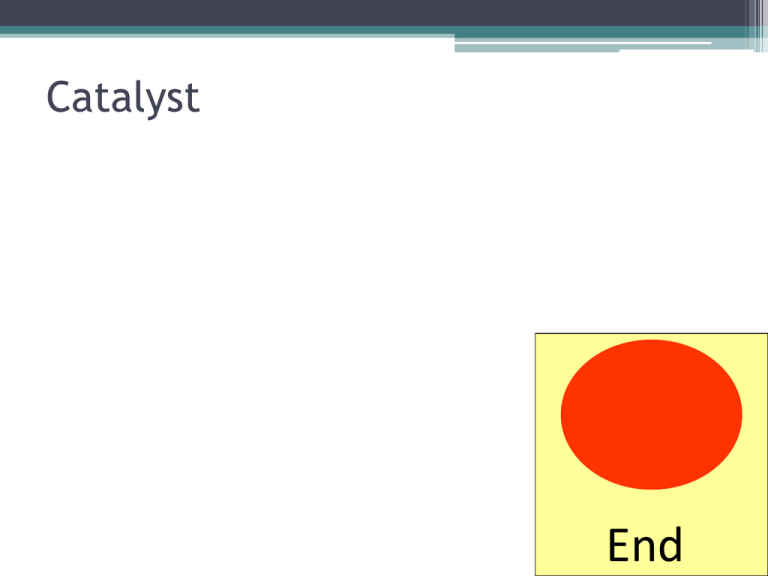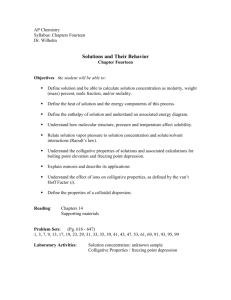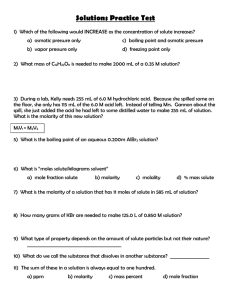Colligative Properties
advertisement

Catalyst End Colligative Properties Lab Lecture 4.7 – Colligative Properties Today’s Learning Targets • LT. 4.11 – I can express the concentration of a solution in terms of mass percentage, mole fraction, molarity, and molality. • LT 4.13 – I can explain the concept of colligative properties and calculate the freezing point depression and/or the boiling point elevation of a given solution. Solution Chemistry • Recall, ▫ Solute - The substance in the smaller amount. Substance being dissolved ▫ Solvent – The substance in the larger amount. Substance that does the dissolving. Solute + Solvent Solution Mass Percent • We can determine the percent of a solute in a solution by using the equation: Mass of Component in Solution Mass % = Mass of Solution 100 Parts per Million (ppm) • Oftentimes, the concentration of a solute is very low when compared to the solvent. • We use parts per million in this case: Mass of Component in Solution ppm = 10 6 Mass of Solution Class Example • A solution is made by dissolving 13.5 g of glucose (C6H12O6) in 0.100 kg of water. What is the mass percentage of solute in this solution? Table Talk • A 2.5 g sample of groundwater was found to contain 5.4 μg of Zn2+. What is the concentration of Zn2+ in parts per million? Molarity • Recall, the molarity of the solution can be calculated by: Moles of Solute Molarity = L of Solution Molality • We can also calculate the molality of a solution by: Moles of Solute Molality = kg of solvent Colligative Properties • Colligative Properties are properties that depend only on the quantity of a substance, not the identity of the substance. • The following are all colligative properties: ▫ ▫ ▫ ▫ Vapor Pressure Lowering Boiling – Point Elevation Freezing Point Depression Osmotic Pressure Boiling Point Elevation • When you dissolve a solute in a solution, you create more substances for the solvent to interact with. • This increased interaction makes it harder for the solvent to escape, so the boiling point is increased. • We can calculate this elevation using the equation: Tb iK b m • Tb = Increase in boiling point • i = Vant hoff factor (how many ions formed when dissolved) • Kb = Molal boiling point depression constant • m = Molality of solution Freezing Point Depression • When you dissolve a solute in a solution, you create more substances for the solvent to interact with. • This increased interaction makes it harder for the solvent to form the ordered solid arrangement. • We can calculate this elevation using the equation: Tf iK f m • Tf = Change in freezing point • i = Vant hoff factor (how many ions formed when dissolved) • Kf = Molal freezing point depression constant • m = Molality of solution Class Example • Automotive antifreeze consists of ethylene glycol, CH2(OH)CH2(OH), a nonvolatile nonelectrolyte. Calculate the boiling point and freezing point of a 25.0 % solution of ethylene glycol in water Table Talk • Calculate the freezing point of a solution containing 0.600 kg of CHCl3 and 42.0 g of eucalyptol (C10H18O), a fragrant substance found in the leaves of eucalyptus trees. The typical freezing point is CHCl3 is -63.5 oC. Molar Mass from Colligative Properties • From colligative properties, the molar mass of an unknown substance can be determined if mass of dissolved solute, mass of solvent, change in freezing/boiling point, and K are known. T m K moles of solute m kg of solvent Class Example • A solution of an unknown nonvolatile nonelectrolyte was prepared by dissolving 0.250 g of the substance in 40.0 g of CCl4. The boiling point of the resultant solution was 0.357 oC higher than that of the pure solvent. Calculate the molar mass of the solute. Table Talk • Camphor (C10H16O) melts at 179.8 oC, and it has a particularly large freezing point depression constant, Kf = 40.0 oC/m. When 0.186 g of an organic substance of unknown molar mass is dissolved in 22.01 g of liquid camphor, the freezing point of the mixture is found to be 176.7 oC. What is the molar mass of the solute? White Board Problems Question 1 • Which of the following aqeuous solutions has the highest boiling point? a. 0.5 m NaCl b. 0.5 m KBr c. 0.5 m CaCl2 d. 0.5 m C6H12O6 e. 0.5 m NaNO3 Question 2 • You dissolve 2 moles of NaCl in 450. kg of H2O. What is the freezing point depression if Kf for this solution is 1.86 oC/m? Question 3 • How many moles of Na2SO4 must be added to 500 mL of water to create a solution that has a 2 M concentration of Na+? Question 4 • When 31.0 grams of a nonionic substance is dissolved in 2.00 kg of water, the observed freezing – point depression of the solution is 0.93 oC. If Kf is 1.86 oC/m, then what is the molar mass of this substance? Question 5 • How many grams of MgSO4 are in 100.0 mL of a 5 M solution? Closing Time • Read 13.4 and 13.5 (533 to 535 and 539) and answer the essential questions • There will be a formal lab report on this lab! • Do book problems:





